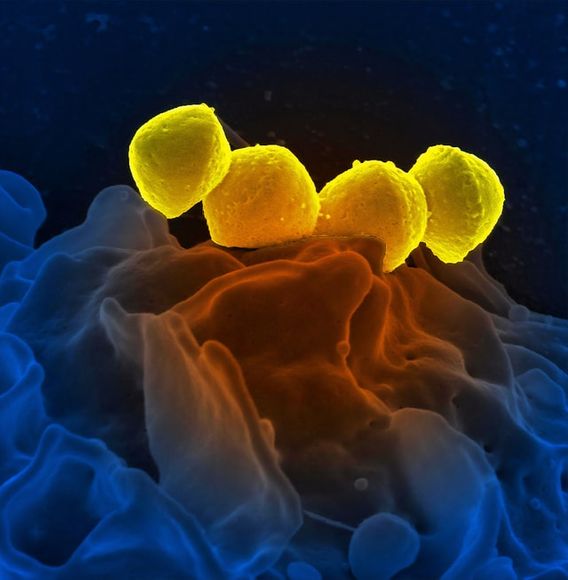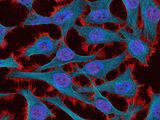Author: Rositsa Tashkova, Master of Molecular Biology and Microbiology
Are we getting closer to the sci-fi scenario for designer babies - will we be able to eliminate genetic mutations from their root, and is it ethical to interfere to such an extent in the emergence and shaping of life - considered a miracle so far?
The discovery of CRISPR-Cas9 gene editing technology raises all these and other questions.
Gene editing - fantasy or reality
Genome editing (also called geneediting) is a group of technologies that enable scientists to change the body's DNA.
Several genome editing approaches have been developed. The CRISPR-Cas9 system (since 2009) has recently become known, which has generated a lot of excitement in the scientific community because itis faster, cheaper, more accurate and more effective than other existing gene editing methods.
Genome editing is of great interest in the prevention and treatment of human diseases. At present, most studies in this regard are done in order to understand the mechanisms of various diseases using cells and animal models.

To do this, scientists edit the genomesof animals , such as mice and zebra fish [ref. 11]because animals and humans have many commongenes. For example, mice and humans share about 85% of their genes! By changing a gene or multiple genes into a mouse, researchers can observe how these changes affect mouse health and suggest how such changes in the human genome can affect our health.
Scientists are still trying to find out if this approach is safe and effective for use in humans. It is used in research into a wide variety of diseases , including cystic fibrosis, haemophiliaand sickle cell anaemia.
What's behind the CRISPR-Cas9 abbreviation and how it works
CRISPR-Cas9 technology is based on a gene editing system that is naturally found in bacteria.
CRISPR arrays allow bacteria to "remember"viruses . If viruses attackagain, bacteria produce RNA segments of CRISPRarrays that recognize and target the corresponding DNA sequencesof viruses. The bacteria then useCas9 or another similar enzyme to cutdna, which disables the virus. It can be said that it is the immune system of bacteria.

The CRISPR-Cas9 system works in a similar way in the laboratory. Researchers created a small piece of RNA with a short sequence, acting as a "guide", which attaches to a certain target sequence of DNA in the genome. RNA is also associated with the Enzyme Cas9. [ref. 10]
As with bacteria, modified RNA is used to recognize DNA sequence, and the Cas9 enzyme cuts DNA at the target site.
CRISPR-Cas9 system applications
The technology has been used for functional inactivation of genes in human cell lines and cells (in laboratory conditions), for the study of the Candida albicans fungus, for modifying yeastsusedfor the production of biofuels and genetically modifying crops. [ref. 1] CRISPR can also be used to modify mosquitoesso that they cannot transmitdiseases such as malaria [ref. 2].
CRISPR-Cas9 can also be used as a diagnostictool. Instead of the Cas9 enzyme, another similar enzyme can beused, such as Cas13, which, in addition to cutting the target area of DNA, also begins to cut RNAindiscriminately , which can be used for signaling in diagnostic tests.

For example, in 2018, the SHERLOCK test was established, to which molecules of RNA have been added, which signal when cut by Cas13.
CRISPR as gene therapy and can it be used as a treatment
Scientists are developing gene therapies (treatments including gene editing) to prevent and treat diseases inhumans.
There are two different categories of gene therapies: germ therapy and somatic therapy.
Germ line therapies alter DNA in reproductive cells (sperm and eggs). Changes in the DNA of reproductive cells are passed down from generation to generation.
Somatic therapies, on the other hand, are aimed at non-reproductive cells, and the changes made in these cells affect only theperson who receives gene therapy, that is. not passed on to his generation.

Successful cases of gene therapy and CRISPR treatment
In 2015, scientists in the UK successfully used somatic gene therapy to treat a little girl namedLayla. [ref. 4]
In the end, this therapy saved Leila's life. However, this type of treatment is still experimental , as there are many technical barriers and ethical problems associated with genomeediting.
It was recently reported that two people with beta thalassaemia and one with sickle cell anemia no longer need a blood transfusion after their own stem cells from their bone marrow were genetically edited with CRISPR. [ref. 5]
These are the first patients officially reported to have undergone CRISPR gene therapy.
Beta thalassaemia and sickle cell anemia are conditions caused by mutations that affect hemoglobin - the protein that carries oxygen in red bloodcells. Patients with severe forms of disease require regular blood transfusions.

Read more:
There are a very small numberof people who carry themutations for these diseases, but do nothave any symptoms , because inadulthood they continue to produce fetal hemoglobin.
In thisstudy, stem cells from patients' bone marrow were extracted and the gene that excluded fetal hemoglobin production was deactivated by CRISPR.
The remaining cells of the bone marrow are killed by chemotherapy , then replaced with edited cells. This is done to ensure that new blood cells are produced by edited stemcells, but chemotherapy can have serious side effects.
Read more:
The first two patients with beta thalassaemia no longer need a blood transfusion. They were subjected to gene therapy 15 months ago and 5months ago. [ref. 6]
The three patients experience some adverse effects from chemotherapy, but editing the gene through CRISPR currently seems safe.However, patients will be monitored for the rest of their lives.
Technical barriers to the use of the technology
Although CRISPR technology is better than older gene editing technologies, it is not perfect. Sometimes shears happen in the wrongplace . Scientists are still not sure how theseerrors can affect patients.
Assessing the safety of gene therapies and improving gene editing technologies are critical steps toensure that they can be appliedto patients.
But CRISPR's ability to safely edit genes in human embryos has been called into question after several recent reports describing huge damage to the DNA ofembryos undergoing editing.
The experiments described in each of the three reports published as reprints on the bioRxiv server aimed to edit only one gene. But the results show large-scale, unforeseen stretches of DNA that have been erased or rearranged in the areas around the target sequence.
While previous research has shown that genetic editing can lead to mutations away from the target region, these new studies draw attention tomore localized damage - including larger SEQUENCES of DNA that could be overlooked by traditional safety screenings.
These studies were intended for research purposesonly , meaning that the embryos were destroyed after the experiment was completed. But in response to their findings, many researchers have expressed their objections to continuing experiments with embryo editing. [ref. 12]
Is it ethical to interfere with our own nature
In the first place, genome editing should be safe before it can be used totreat patients.
Most of the changes in gene editing are limited to somatic cells and affect only certain tissues, not being transmitted from one generation to another. [ref. 9]
Editing the sex cells and the genome of the embryo poses a number of ethical challenges, including whether it would be permissible to use this technology to improve human traits such as height orintelligence.

In 2018 Chinese scientist He Jiankui reported that he performed gene editing in 2 embryos, The children's father is HIV-positive, and He Jiangwei used CRISPR to introduce changes in the genome of the embryos to make them resistant to the virus (a small number of people are inherently resistant to HIV infection because they have a mutation in the receptor that the virus binds to infect cells).
The incident has sparked intense resentment in the scientific community, with many scientists calling for a moratorium on the use of the technique in human embryos because they believe it is unethical and it is too early to take such steps.
He Jiankwei has now been sentenced to three years in prison and a $430,000 fine. [ref. 7]
Currently, nothing is known about the condition and health of babies. There is evidence that editing has not only failed - some babies' cells carried the mutant gene, others have not, but perhaps editing has led to other unwanted mutations- which could prove detrimental to children's lives in the future. [ref. 8]
Some other ethical questionsthat scientists andsociety should consider are:
- Is it ok to use gene therapy on an embryo when it is impossible to obtain permission from the embryo for treatment? Is getting permission from parents enough?
- What happens if gene therapies are too expensive and only wealthy people can access and afford them?
- Will some people use gene editing for traits that aren't important for health, such as athletic ability or stature?
Most people agree that scientists do not currently have to edit the genomes of germ cells. Many countries and organizations have strict regulations to prevent germ line editing for the reasons listed above. Only the future will show whether CRISPR will spark a revolution in medicine or be dismissed as unreliable and unethical technology.
Read more:
How genes determine resemblance to our parents
How nucleic acids DNA and RNA orchestrate life
Does it make sense to take a genetic test?









